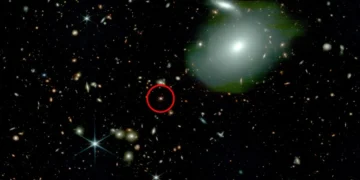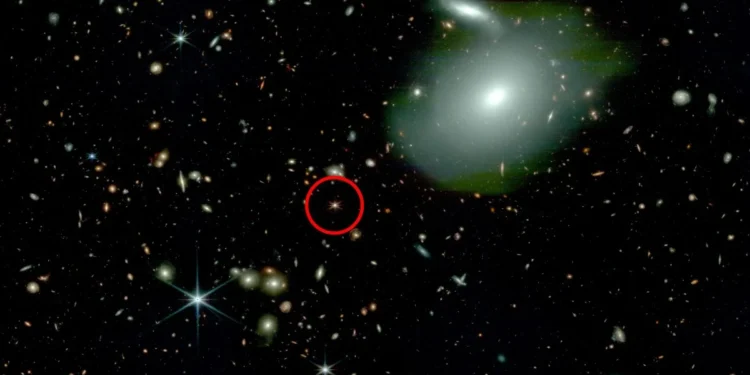The James Webb Space Telescope’s (JWST) discovery of isolated ancient quasars is reshaping our understanding of the universe’s early years. Quasars, known for their bright centers powered by supermassive black holes, were traditionally thought to form in dense, galaxy-rich regions. However, JWST has observed several of these quasars in surprisingly sparse environments, raising questions about their formation and evolution.
Ancient Quasars and Their Unexpected Isolation
Quasars are some of the universe’s brightest and most energetic phenomena, powered by supermassive black holes consuming surrounding gas and dust. This process releases tremendous energy, making them visible even across billions of light-years. Quasars have been detected dating back to a few hundred million years after the Big Bang. Traditionally, it was believed that such objects formed in regions where matter was densely concentrated, providing the necessary material to fuel their growth. However, the recent JWST findings reveal that some of these quasars exist in relative isolation, away from the dense environments scientists expected.
The James Webb Space Telescope offers an unprecedented view into the universe’s infancy, capturing light from over 13 billion years ago. With its advanced imaging technology, JWST allows astronomers to study the “quasar fields”—the areas surrounding these ancient objects—with unparalleled detail. In a study led by MIT researchers, JWST observed the surroundings of five known quasars, revealing a surprising diversity. While some quasars were surrounded by numerous galaxies, others appeared to exist in vast cosmic voids, challenging the standard model of quasar formation.
Why Are These Findings So Significant?
This discovery is more than just an astronomical curiosity; it has profound implications for our understanding of cosmic evolution. The findings contradict the prevailing theory that the densest regions of dark matter would naturally harbor the most massive black holes and galaxies. If quasars can form in isolation, then our models of how the universe evolved, particularly in its earliest stages, may need revising. It suggests that the processes behind black hole growth and quasar formation might be more complex than previously thought, involving factors beyond just dark matter concentration.
Challenging the Standard Model of Cosmic Evolution
For decades, cosmologists believed that dark matter served as a gravitational scaffold for the formation of galaxies and other structures. This “cosmic web” of dark matter would attract gas and dust, creating the conditions for stars, galaxies, and black holes to form. Quasars, being among the most massive early objects, were expected to be found in regions with high concentrations of dark matter. Yet, the JWST’s discovery of isolated quasars indicates that this might not always be the case. For example, while one quasar studied had more than 50 surrounding galaxies, another of similar age and size had just two nearby galaxies.
The Mystery of Isolated Quasars
One possible explanation for the existence of these isolated quasars is that their surroundings are shrouded in cosmic dust, making nearby galaxies difficult to detect even for JWST. Another theory suggests that these quasars might be tapping into hidden gas reserves or utilizing different accretion processes to grow. The lack of visible galaxies could also indicate that these regions contain unique dark matter configurations that challenge our current understanding. Whatever the cause, the existence of these isolated quasars suggests that the universe’s early structure may be more varied than previously assumed.
Implications for Dark Matter Studies
The discovery of these isolated quasars also has implications for our understanding of dark matter’s role in cosmic evolution. Dark matter is believed to make up about 27% of the universe’s total mass and energy, forming the framework upon which galaxies and other cosmic structures build. If some of the universe’s earliest quasars can form without dense dark matter regions, this could mean that our models of how dark matter influences the formation of stars and galaxies may need adjustment. The findings suggest that dark matter’s relationship with visible matter, like stars and black holes, might be more flexible than we currently understand.
With the discovery of isolated quasars, scientists are eager to continue exploring the early universe using JWST. One of the primary objectives is to search for faint or hidden galaxies around these quasars, which might reveal clues about their isolated appearance. Additionally, researchers aim to refine computer models to simulate the early universe’s evolution better. By comparing these new models with the data provided by JWST, scientists hope to unlock more secrets about how quasars and other early cosmic structures formed, evolved, and interacted.
The Broader Impact on Cosmology
The discovery of these ancient, isolated quasars could reshape how we think about the universe’s evolution. It forces scientists to reconsider assumptions about the role of dark matter in forming galaxies and black holes. This discovery also highlights the dynamic and unpredictable nature of the cosmos. Understanding how these quasars grew in such environments might offer insights into the growth of supermassive black holes and their impact on the universe’s evolution. It could also provide a deeper understanding of how energy and matter interacted in the universe’s first billion years.
The JWST’s ability to look back in time with such clarity marks a significant advancement in observational astronomy. As more data from the telescope is analyzed, scientists expect to encounter more surprises that challenge existing theories. Each new observation adds another piece to the cosmic puzzle, helping scientists refine their understanding of the universe’s earliest moments. The study of isolated quasars is just one example of how JWST is pushing the boundaries of what we know about space and time.
Conclusion: A New Era of Cosmic Exploration
The James Webb Space Telescope has opened a new chapter in our exploration of the universe, revealing mysteries that were once beyond our reach. The discovery of isolated ancient quasars challenges our understanding of the early universe’s structure and evolution, suggesting that there is much more to learn about how black holes and galaxies form. As scientists continue to investigate these findings, the JWST will undoubtedly play a crucial role in uncovering the hidden intricacies of the cosmos, offering a deeper understanding of the universe’s origins and its future trajectory.
Reference:
EIGER. VI. The Correlation Function, Host Halo Mass, and Duty Cycle of Luminous Quasars at z ≳ 6” by Anna-Christina Eilers, Ruari Mackenzie, Elia Pizzati, Jorryt Matthee, Joseph F. Hennawi, Haowen Zhang, Rongmon Bordoloi, Daichi Kashino, Simon J. Lilly, Rohan P. Naidu, Robert A. Simcoe, Minghao Yue, Carlos S. Frenk, John C. Helly, Matthieu Schaller and Joop Schaye, 17 October 2024, The Astrophysical Journal



















